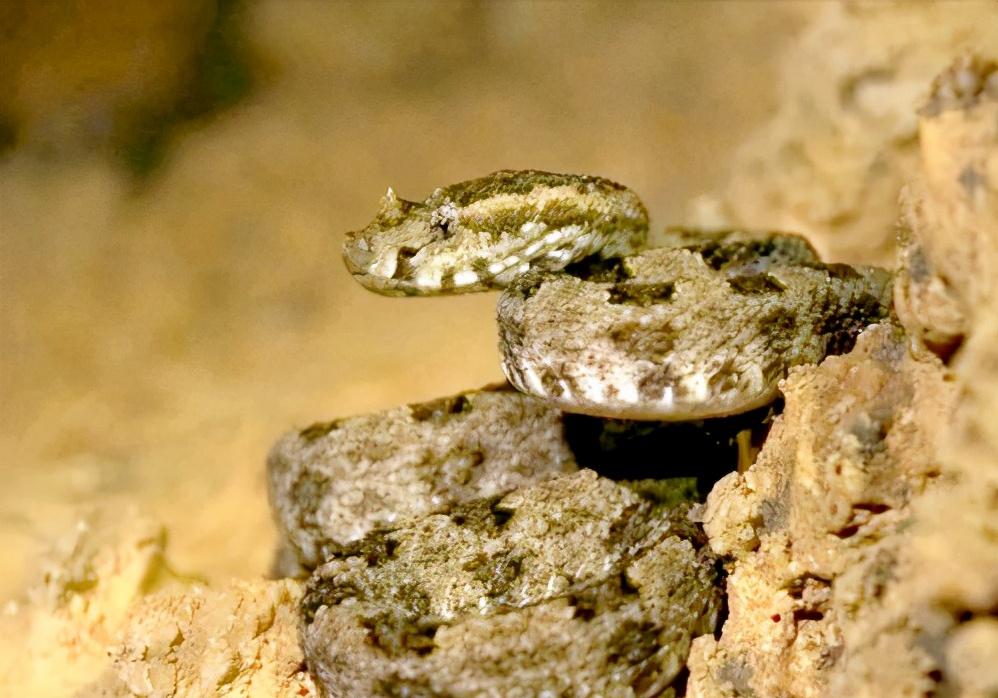Near the Annan Mountains in Southeast Asia, there is a local venomous snake, the three-spined viper, which is often considered a dragon by the locals because of the horns on its head, in fact they are just an ordinary poisonous snake, they were only recognized as a separate species in 2009, the three-spined viper is different from other members of the original spearhead viper family, they prefer to prey on bats in caves, although they are also distributed in the jungles of the Annan Mountains, but they prefer to act as a kind of "cave pit viper" that lives in caves. 。

Three-spined proto-spearhead viper
In the various caves in the Annam Mountains, there are a large number of tomb bats and hoofed bats, which are an important part of the cave ecosystem, every night they have to go outside the cave to hunt insects, and the next morning they will come back, the bat feces piled up under the cave can not only become luminous sand as a traditional Chinese medicine, but also provide food for insects in the cave, and the microorganisms bred by bat feces can provide food sources for cave creatures such as crickets. Bats themselves can also provide a food source for the three-spined proto-spearhead viper, and when the cave water recedes, the three-spined proto-spearhead viper often comes to the cave in the mountain range to prey on bats and frogs. The three-spined viper is an endangered species endemic to Annan Mountain, living most of the time in the jungle outside, but this pit viper will occasionally come to the cave to prey, they like small mammals, but there are no rodents running around on the rocks of the cave, and the target of this cave pit viper is naturally aimed at the bat swarm hanging upside down on the top of the cave. The three-spined viper has no hearing, so in the dark cave, they must rely on other organs, pit vipers have a special method of detecting warm bodies - stereo thermal vision, the cheek sockets on both sides of their heads are like infrared satellite sensors, which allow the snake to see the thermal image of the surrounding environment. The main target of the three-spined proto-spearhead viper is the old, weak and inexperienced bat, they only need to let a bat accidentally fall down, as a good ambush master, the three-spined proto-spearhead viper can wait for hours below the bat swarm. The three-spined proto-spearhead viper swallows its forked tongue to feel the smell in the air, and then determines whether the owner of the smell is a hunter or a prey, or some other creature. Frogs that also live in caves are also one of the foods of the three-spined viper, but the protective color of cave frogs can provide perfect visual protection with the cave walls, and their extremely low body temperature does not expose the location.
The three-spined spearhead viper was mistaken for a type of horned viper in 2000, and it was not until 2009 that it was reconsidered as a separate three-spined spearhead viper, and the biggest difference between them and the horned viper is the horn shape on the head, and their body size is generally larger than the horned viper.
The original spearhead viper belongs to the viper family, a highly venomous snake under pit viper dentistry, they are a large family, there are currently a total of 14 species, the size of about 1 meter - 2 meters, mainly small mammals, birds, frogs and snakes as the main diet, mainly distributed in East And Southeast Asia. The 14 species of original spearhead pit vipers are: Kakuhara spearhead viper, Dabie Mountain spearhead viper, Ryukyu original spearhead viper, yellow-green original spearhead viper, cauliflower original spearhead viper, Burmese Northern Yuan spearhead viper, Hiyamahara spearhead viper, Maolanyuan spearhead viper, Mangshan ironhead, sharp scale original spearhead viper, three-spined original spearhead viper, Baodaoyuan spearhead viper, Yuebei original spearhead viper, Xiangcheng original spearhead viper and so on.
Dabie Mountain original spearhead viper
Kiyama Hara spearhead viper
Although the original spearhead pit viper is a large family, most of their species are narrowly distributed, such as the famous Mangshan soldering iron head, whose scientific name is also called Mangshan Original Spearhead Viper, which was discovered by scientists in 1990 and is now only distributed in the Mangshan area of Chenzhou, Hunan Province, while the Dabie Mountain Original Spearhead Viper was only discovered in 2012, they are only distributed in the Dabie Mountain area, and the Himalo original spearhead viper was also found in the southern foothills of the Himalayas in 2012, and this original spearhead viper is only distributed near the southern slope of the Himalayas.